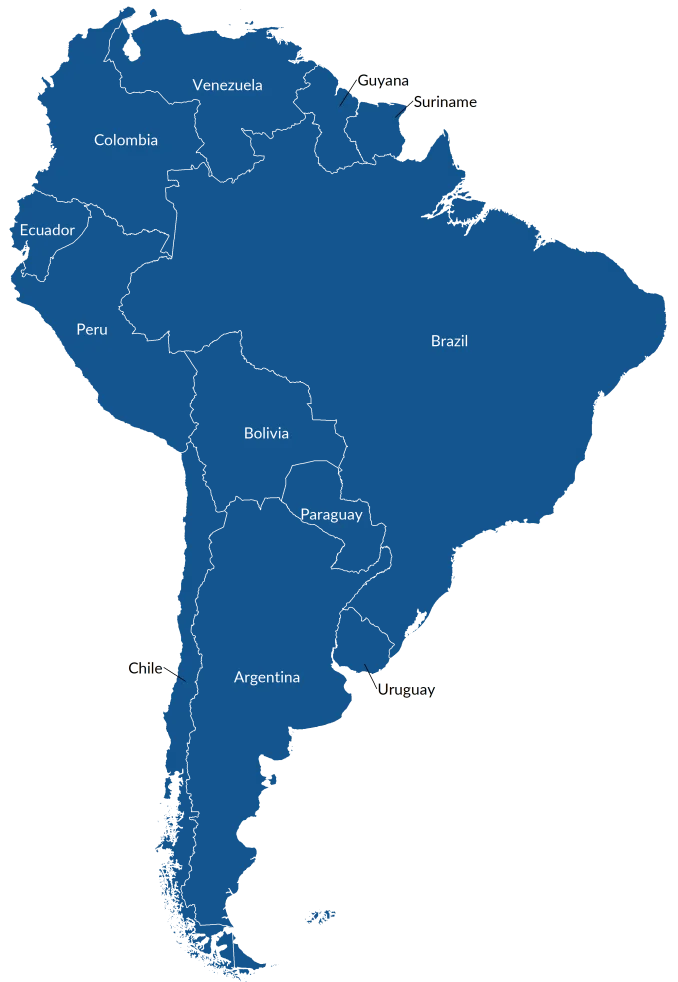About South America
South America is a continent that is largely in the Southern Hemisphere of the Western Hemisphere, with a little amount in the Northern Hemisphere. With an area of about 17.84 million square kilometers, it ranks fourth in terms of continent size. With almost 430 million people living there, it is also the fifth most populous continent.
Facts about South America continent |
|
|---|---|
| Location | Western Hemisphere |
| Size | 17.84 million square kilometers |
| Population | Approximately 430 million people |
| Number of countries | 12 (Argentina, Bolivia, Brazil, Chile, Colombia, Ecuador, Guyana, Paraguay, Peru, Suriname, Uruguay, and Venezuela) |
| Major bodies of water | Caribbean Sea, Pacific Ocean, Atlantic Ocean |
| Major mountain range | Andes |
| Largest river | Amazon River |
| Major animal species | Jaguar, anaconda, capybara |
| UNESCO World Heritage sites | Machu Picchu, Galapagos Islands, Iguazu Falls, and more |
| Major economies | Brazil (agricultural products, oil and gas), Chile (copper, other minerals), Argentina (wine, beef) |
| Popular tourist destinations | Machu Picchu, Rio de Janeiro, Galapagos Islands, Patagonia. |
Physical Characteristics of South America
Size
South America, which spans an area of over 17.84 million square kilometers, is the fourth-largest continent in the globe. It is situated in the Western Hemisphere and has the Pacific, Atlantic, and Caribbean seas as its external boundaries.
Climate
South America has a diverse range of climates due to its large size and varied geography. The equator runs through the continent, resulting in tropical and equatorial climates in many areas. The Amazon rainforest, for example, experiences hot and humid conditions year-round. The southern part of the continent, on the other hand, experiences cooler temperatures due to its proximity to Antarctica.
Landscape
South America is known for its stunning landscapes and varied geography. The Andes mountain range runs the length of the continent and is home to many active and dormant volcanoes. The Amazon rainforest covers a significant portion of the continent, with its dense forests and winding rivers. The continent is also home to the world’s largest wetland area, the Pantanal, as well as the Atacama Desert, one of the driest places on earth. Other notable landscapes in South America include the Brazilian Highlands, the Andean Altiplano, and the Guiana Highlands.
Historical Significance of South America
-
Pre-Columbian Civilizations
Before the arrival of Europeans in the late 15th century, South America was home to many advanced civilizations, including the Incas in Peru, the Mayans in Central America, and the Aztecs in Mexico. These civilizations made significant advancements in areas such as agriculture, architecture, and astronomy, leaving behind impressive ruins and artifacts that are still studied and admired today.
-
European Colonization
Beginning in the late 15th century, European powers such as Spain and Portugal began to colonize South America, establishing settlements and bringing with them new technologies, religions, and cultures. This period of colonization had a profound impact on the continent, with many indigenous populations suffering greatly due to forced labor, disease, and cultural suppression.
-
Independence Movements
In the 19th century, South American countries began to gain independence from their European colonizers, leading to the formation of new nations such as Brazil, Argentina, and Chile. These independence movements were often marked by intense conflict and violence but ultimately paved the way for greater self-determination and autonomy.
-
Dictatorships and Civil Wars
Throughout the 20th century, many South American countries experienced periods of political instability, including military dictatorships and civil wars. These events had significant impacts on the continent’s social, economic, and political landscapes, with some countries still struggling to overcome the legacies of these periods of turmoil.
Top 10 places to visit in South America
| Place | Country |
|---|---|
| Machu Picchu | Peru |
| Rio de Janeiro | Brazil |
| Buenos Aires | Argentina |
| Galapagos Islands | Ecuador |
| Torres del Paine NP | Chile |
| Salar de Uyuni | Bolivia |
| Angel Falls | Venezuela |
| Cartagena | Colombia |
| Iguazu Falls | Argentina |
| Atacama Desert | Chile |
FAQs
Q: What is the largest country in South America?
A: Brazil is the largest country in South America by both area and population.
Q: What is the highest mountain in South America?
A: Mount Aconcagua, located in the Andes on the border between Argentina and Chile. It stands 22,841 feet (6,962 meters) tall.
Q: Where is the driest place in South America?
A: The Atacama Desert, located in Chile.

